“As a consequence of her victory in the 1971 elections, Indira Gandhi has successfully magnified her figure as the one and only leader of national dimensions. However, if power is voluntarily surrendered by a predominant section of the people to one person and at the same time opposition is reduced to insignificance, the temptation to ride roughshod over legitimate criticism can become irresistible. The danger of Indira Gandhi being given unbridled power shall always be present.”
Khushwant Singh, 1971
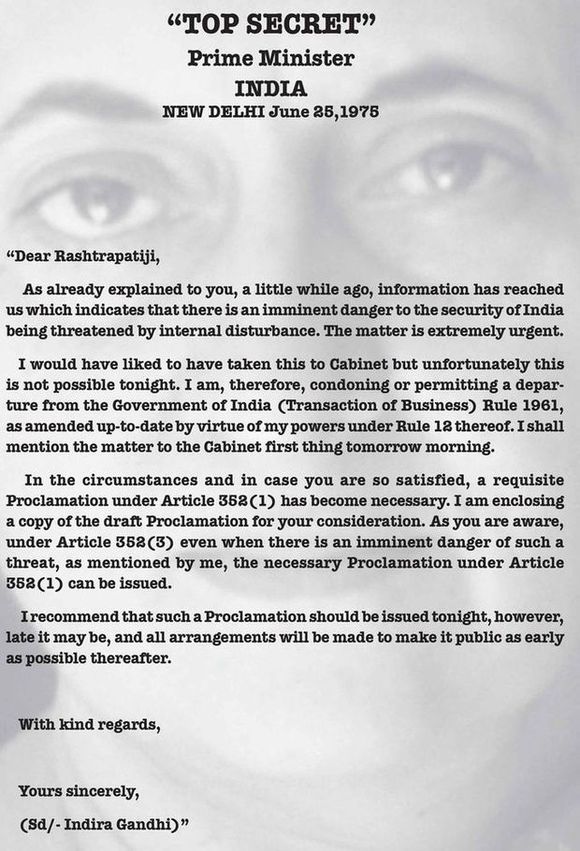
On a hot afternoon last month, the daily dak (post) received at the Union human resources development ministry contained an anonymous letter and a pamphlet. The letter said the Ambedkar Periyar Study Circle, a small group of students of IIT Madras, was “creating hatred among the students in the name of caste and trying to create hatred against the honourable Prime Minister and the Hindus.” The accompanying pamphlet of the APSC highlighted a speech by an academic, which was critical of the Narendra Modi government.
It was routinely sent to the director of the institute for comments. Within 24 hours, the APSC was banned, although it was later clarified to be a temporary measure. The students were reportedly stripped of their privileges like using the IIT email and the institute's notice board.
“I am reminded of the Emergency. In fact, I have not seen such swift action even during the Emergency,” said an activist in Tamil Nadu, confessing he was afraid to go on record.
The Emergency, which was in place from June 25, 1975 to March 21, 1977, was the darkest period in independent India, when freedom became the biggest casualty. It is also an almost forgotten period, which is remembered mostly by people of that generation and that, too, only under similar duress.
Indira Gandhi was more than a legend then, after showing her seniors in the Congress that she was no “goongi gudiya” (dumb doll) and that hers was not a “petticoat government”. She nationalised the banks in 1969 and abolished the Privy Purses (the payment made to royal families) the next year. In the Lok Sabha elections held in 1971, she won 352 of 518 seats. Later in the year, she emerged victorious in the war against Pakistan, which resulted in the formation of Bangladesh. Perhaps forgetting he belonged to the opposition Jana Sangh, Atal Bihari Vajpayee called her “Durga”. It was the best of times for Indira.
Yet, it was also the beginning of the worst of times. Raj Narain, the Socialist Party candidate who was defeated by Indira in Rae Bareli, challenged her election in the Allahabad High Court, citing electoral malpractices.
By then, Sanjay Gandhi's escapades had started to hurt Indira. His small car project, launched as a private-sector venture, was growing increasingly unpopular in the pre-liberalised socialist era, leading to charges of nepotism. Soon, it was renamed the “people's car” and banks were lending money to a non-manufacturing unit. Haryana chief minister Bansi Lal acquired the most fertile land in his state for the project. Awkward questions in Parliament and criticism in the media added to Indira's frustration. Her trip downhill had begun.
It started quite unexpectedly. Early in 1974, a college in Gujarat increased mess charges. Students protested and the aim of their agitation soon turned into something big. They dreamed of building a new India, where prices were affordable. The Nav Nirman agitation had a butterfly effect. In faraway Bihar, students protested under the leadership of a Gandhian, Jayaprakash Narayan. After Indira repressed it with all the might of the state, JP's goal was transformed: he wanted the transformation of the social order in the countryside, across India.
By May that year, 17 lakh employees of the railways struck work for 20 days, demanding a pay hike. The strike was led by George Fernandes, who was president of the All India Railwaymen's Federation. Indira retaliated by arresting 20,000 striking workers, including Fernandes.
Its aftershocks were felt across the country. On June 12, 1975, a nervous Indira received the news of the Allahabad High Court's verdict in her case against Narain. She had used Yashpal Kapoor, officer on special duty in the PM's secretariat, for election work. And government officials from Uttar Pradesh had provided electricity, arranged for loudspeakers, and built the dais from which she addressed rallies. Justice Jagmohan Lal Sinha found Indira guilty of malpractices, and set aside her election. Though Sinha stayed the execution of his order for 20 days to give her time to appeal in the Supreme Court, the opposition demanded that she resign immediately. They also threatened civil disobedience.
The Congress stood steadfast behind Indira. Sanjay organised rallies, forcing the entire fleet of Delhi's buses to take people to the venues. Both mother and son patronised coteries everywhere, including in the bureaucracy. For those who resisted, like the media and the opposition, they had some “other actions” in mind. Indira even looked for someone pliable to keep the PM's chair warm―like Tamil Nadu Chief Minister J. Jayalalithaa did with O. Panneerselvam―till her legal worries were over. But she could not trust anyone enough.
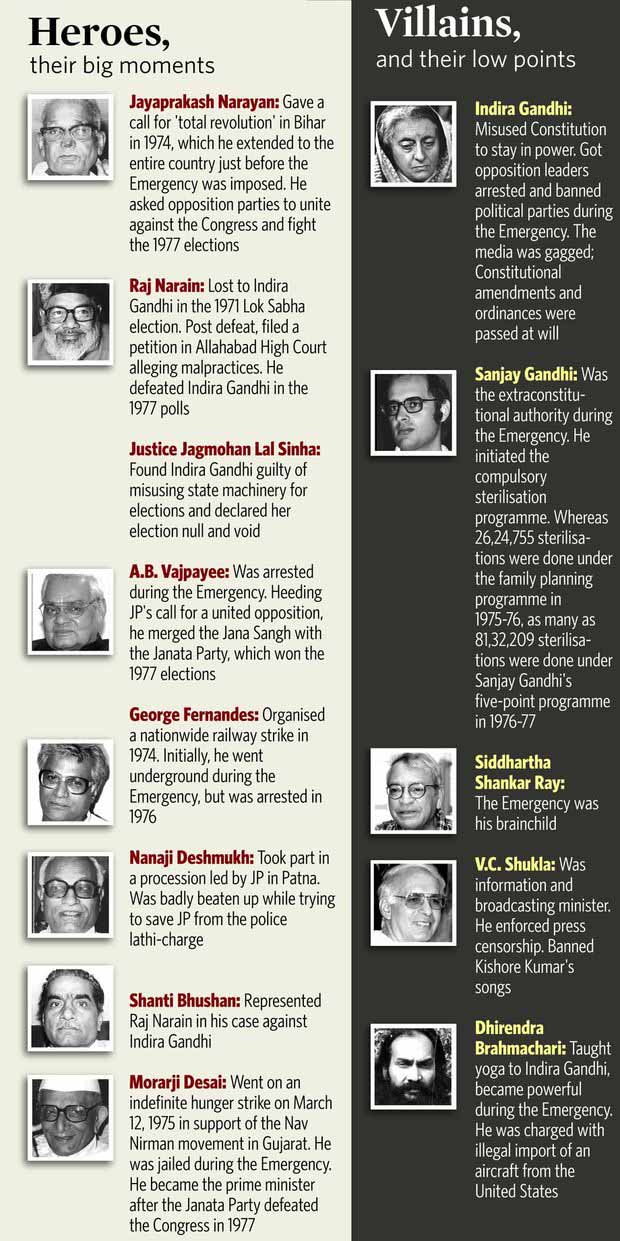
Finally, she approached the single-judge vacation bench of the Supreme Court arguing that her continuation as prime minister was in “national interest”. On June 24, Justice V.R. Krishna Iyer gave her a conditional stay: she could continue as prime minister, but she did not have the right to vote in the Lok Sabha till the Supreme Court had disposed of her appeal. But the opposition did not see the sense of having a PM who had lost her credibility.
By midnight on June 25, JP was arrested and so were most opposition leaders, and the threat to Indira's power was presented as a threat to the nation's internal security. Indira made president Fakhruddin Ali Ahmed sign the promulgation of the Emergency without even getting the cabinet approval.
The Emergency gave the government the power to suspend Article 19 of the Constitution, from which flowed much of our democratic rights such as freedom of speech and expression; freedom to assemble peacefully; to form associations and unions; to move freely all over the country; to buy, hold and sell property; and to practise any profession or occupation, trade or business. Under the new rules, the Centre had the power to give directions to the states. It could tell courts not to entertain people who wanted their rights to be enforced. Most of it was the brainchild of Siddhartha Shankar Ray, who was the chief minister of West Bengal and a brilliant lawyer. Only a coterie comprising Ray, Indira's close aide R.K. Dhawan, Bansi Lal, minister of state for home affairs Om Mehta and Delhi's lieutenant governor Krishan Chand knew of these plans.
The media and the opposition leaders were the first targets. Bahadur Shah Zafar Marg, Delhi's Fleet Street where most of the national dailies had their offices, was subjected to long power cuts. Then came the arrest of senior journalists on the flimsiest of grounds. Congress chief ministers fell over each other implementing the plans of Indira and Sanjay. Bansi Lal had senior journalist M.L. Kak arrested on charges of blowing up post and telegraph offices in Hissar. Opposition leader Devi Lal, already imprisoned in Hissar, was sure that Kak had come to interview him. The story of Kuldip Nayar's arrest is all too well known. Most of the arrests were done under the Maintenance of Internal Security Act. Newspapers had official censors reading through every story and editorial. Many editors preferred to leave the editorial columns blank.
More horror stories were coming in. Sanjay's cronies were zealously implementing his five-point agenda. Sterilisation camps were routine and government officials were trying hard to get the “maximum number of cases and beat the target”. A person who studied in a government school in Delhi at that time said the fear of sterilisation was such that once parents did not send children to school for three days, because an immunisation and vaccination camp was scheduled on those days. In many cases, young boys and old men were vasectomised. “Such was the impact that the word family planning was used very cautiously by the Indian government since,” said Pramod Kumar, director of the Institute for Development and Communication, Chandigarh.
Stories of torture came from jails, but were not published. “There was hardly any resistance,” said Kak. Those who raised their voice feared “the midnight knock”. Most of the arrests, without warning or warrants, were carried out in the middle of the night. Freedom fighter Bhim Sen Sachar, then 82, and seven others found themselves in jail for writing an open letter to Indira. “... the common people of Delhi now talk in hushed tones as they do in communist societies, they do not discuss politics in the coffee house or at the bus stand and look over their shoulders before expressing any opinion. An atmosphere of fear prevails and politically conscious citizens differing from your viewpoint prefer to observe a discreet silence, with some of them afraid of the midnight knock on their door,” read the letter.
Indira went ahead with her 20-point development agenda to which Sanjay added his five points. “We were ordered to paste these pamphlets on our shop walls. Those who refused were arrested,” said a grocery store owner.
The Emergency regime, however, brought discipline to the country. Trains and buses ran on time, office goers were punctual, schools and colleges were free of strikes. Even the trade unions stopped protests. Then began the build up of Indira as an icon, complete with eminent artist M.F. Husain painting her as Durga.
For Parliament and the judiciary, it was clearly the worst of times. Ten months into the Emergency, a bench comprising five senior-most members of the Supreme Court had to decide whether a habeas corpus petition could be maintained to ascertain if a detention was in compliance with MISA. Four of the five judges held that both legislative and executive actions were immune from judicial review. Dismissing the petition, they said the right to life and personal liberty were bounties given to citizens by the state, and hence could be withdrawn in times of Emergency.
Justice H.R. Khanna's dissenting note maintained that the rule of law required that right to life and personal liberty could not be suspended under any circumstances and that the legality of the detention could be questioned by the detainee. “A dissent in a court of last resort... is an appeal to the brooding spirit of the law; to the intelligence of a future day, when a later decision may possibly correct the error into which the dissenting judge believes the court to have been betrayed,” wrote Khanna.
That future day was not far away. Confident that the people were with her, Indira lifted the Emergency on March 21, 1977. In the elections that followed, she was swept out of office. Anti-Congress politics was born, and along with it, the idea of coalition politics. The Janata Party won a huge mandate in what was described as “the finest hour of Indian democracy” and it dismantled much of the terrible infrastructure of the Emergency regime. It constituted the Shah Commission to look into “the widespread misuse and abuse of power during the imposition of double emergencies, external and internal in 1975-77.”
The Janata coalition had many shortcomings. Internal bickering and unimpressive performance brought the government down in less than three years, and people voted back to power Indira, who was seen as a victim of political vendetta. The election, however, was not about the Emergency, so it was not clear whether people forgave her for it. But upon her return, the Shah Commission report was trashed and documents pertaining to the Emergency were put away. Every effort was made to wipe away the memory of the dark days. While the Congress was expected to do that, the opposition parties did little to keep alive the memory of the Emergency. Senior BJP leader L.K. Advani once likened Indira to Hitler and the Emergency to the Nazi regime, but he did nothing to set up an Indian equivalent of the Holocaust Museum, although he served as deputy prime minister.
Although many of the opposition leaders claimed their political birth at the feet of JP, there is no monument to him. In 2003, his birth centenary year, the Vajpayee government set up a 100-member committee to commemorate the milestone and filmmaker Prakash Jha was asked to make a documentary. But by the time the film was made, a Congress-led government was in office. “Nothing worthwhile about JP or the Emergency remained after the censors were through,” said M.G. Devasahayam, a former IAS officer, who was the district magistrate of Chandigarh, when JP was held in custody at the Post Graduate Institute of Medical Education and Research in the city.
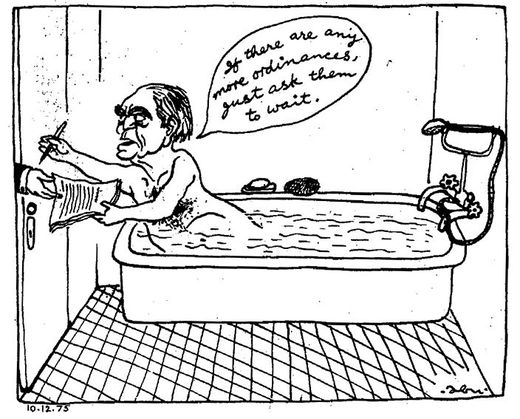 Wrong signal: Abu Abraham's famous cartoon showing the president signing the Emergency proclamation | Courtesy: Abu
Wrong signal: Abu Abraham's famous cartoon showing the president signing the Emergency proclamation | Courtesy: Abu
The letter Indira wrote, with her signature, to Fakhruddin Ali Ahmed, asking him to promulgate the Emergency, is missing. What is available is the typed copy without her signature. The other papers, too, are missing from the home ministry as well as the National Archives of India. It was after several applications under the Right to Information Act and repeated follow-ups that the NAI acknowledged that the papers were with it, but not in a good condition.
A few years ago, Professor Emma Tarlo of the University of London, visited the Nehru Memorial Museum and Library and the Indira Gandhi Memorial Museum in Delhi. There she found books published in 1975-76, which welcomed the Emergency, and those published in the 1977-78 period, which were critical of it. “What we have, then, are two alternative narratives, each with its own vision; one which projects the Emergency as a step into a brighter future, the other which remembers it as a bleak and shameful past,” she wrote in her book, Unsettling Memories: Narratives of India's Emergency. More interesting is her observation that, by 1979, such books were “already subsiding. By 1980, their demise is marked by an absence of new additions that year to the Emergency shelf.”
But like the activist from Tamil Nadu, some others have lately made references to the Emergency. “They are so petrified, they don't open their mouths,” said a retired IAS officer, of her friends who were in service. “We were not so frightened even during the Emergency.”
For the Emergency has become a metaphor for anything dictatorial, repressive and even in the slightest way undermining―however gently or tactfully―freedom of expression, dissent, a different point of view, or an opinion unsolicited. The pressure that was brought on publishers to withdraw the book The Hindus: An Alternative History by Wendy Doniger and the ban on foreign travel by activist Priya Pillai and the gradual financial squeeze of Greenpeace India, smack of a lack of tolerance. “The Emergency and arrests are extreme, these little isolated events make us feel concerned,” said a government officer, who compared the kind of power, popularity and parliamentary strength enjoyed by Modi to what Indira had when she imposed the Emergency.
Modi, who leads the government with a clear majority for the first time in 30 years, evokes almost the same kind of fear as Indira did. Equally, even without anything like an Emergency, the build up of Modi's personality cult is akin to that of Indira. His wish is the party's, and it is now the government's command. There is the constant fear that the PMO is watching.
“Targets are great. But when the effort to meet them is stretched out of fear or desperation for approval, things can go wrong, as they did in the case of sterilisations and arrests then. Such misplaced and ill-founded enthusiasm was visible when the Modi government was putting together its achievements of 100 days, and now of one year. Some ministries even claimed the Manmohan Singh government's achievements to impress Modi. Such fear should not exist,” said a retired bureaucrat.
Nothing is impossible in politics. Yet, leaders across the divide rule out the possibility of another Emergency in India. Some, however, are apprehensive of one man towering way above others, with the rest buckling meekly. B.R. Ambedkar, the father of our Constitution, said as much:
“In India, Bhakti or what may be called the path of devotion or hero worship, plays a part in its politics unequalled to the magnitude by the part it plays in the politics of any other country in the world. Bhakti in religion may be the road to the salvation of a soul. But in politics, Bhakti, or hero worship, is a sure road to degradation and to eventual dictatorship.”
Reels of reality
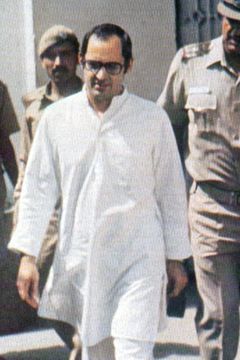 Invisible act: Sanjay Gandhi was booked for the disappearance of the reels of Kissaa Kursee Kaa.
Invisible act: Sanjay Gandhi was booked for the disappearance of the reels of Kissaa Kursee Kaa.
Kissaa Kursee Kaa, directed by Amrit Nahata, was Sanjay Gandhi's nemesis. The film, which blamed Sanjay for most of the excesses during the Emergency, was the reason he was jailed.
A political spoof, the film lampooned Sanjay Gandhi, his car manufacturing dream and Congress supporters like Dhirendra Brahmachari, Rukhsana Sultana and R.K. Dhawan, Indira Gandhi's secretary. In the film, the bad guy tries to woo a mute and helpless heroine named Janata.
A couple of months before the Emergency was declared, the Censor Board received the film for certification. The board referred the matter to the government, and the information and broadcasting ministry wanted 51 cuts. Nahata found it “absurd and frivolous”. The film was later banned.
Nahata challenged the censorship. On July 18, 1975, the court asked him to deliver the prints to the government and directed the government to preserve the negatives and prints in proper condition till the disposal of the writ petition. The court directed that the film be screened for five judges on November 17, 1975. But by then the film had vanished, rather “deliberately destroyed”.
Sanjay and V.C. Shukla, the information and broadcasting minister, were sentenced to jail. District judge O.N. Vohra of the Tis Hazari Court found them guilty of burning the celluloid reels of the film in Sanjay's car plant in Gurgaon.
Voiceless protest

Mere saamne wale khidki mein in Padosan had Sunil Dutt lip-syncing to Kishore Kumar. Mere sapnon ki rani kab ayegi tu had a dapper Rajesh Khanna wooing dimpled beauty Sharmila Tagore in Aradhana. Tere bina zindagi se koi was the soulful hit song from Aandhi, whose heroine was modelled on Indira Gandhi. The evergreen Kishore Kumar was, without a doubt, the voice that thrilled the young and old alike across the country.
The ministry of information and broadcasting wanted the Hindi film industry's 'cooperation' in praising Indira Gandhi's 20-point programme on All India Radio and Doordarshan.
Kumar was not willing to sing; he refused to cooperate in any way. He declined to meet the I&B ministry officials saying he had heart trouble and the doctor had advised him not to see anybody.
Miffed, on April 30, 1976, S.M.H. Burney, secretary, I&B, ordered that all songs of Kumar be banned from AIR and Doordarshan and all films in which he was acting be “listed out for further action”. He also ordered that the sales of gramophone records of his songs be frozen. V.C. Shukla, the I&B minister, approved it all, and four days later, the ban was implemented on radio and TV.
No royal treatment, this
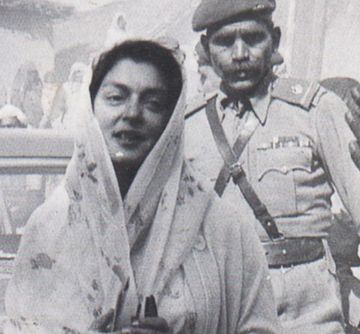
Gayatri Devi, an MP representing the Swatantra Party, and her stepson Lt Col Bhawani Singh, a Mahavir Chakra recipient for gallantry in the 1971 war with Pakistan, were arrested under the Conservation of Foreign Exchange and Prevention of Smuggling Activities Act, 1974. Some gold and dollars were seized from their residences. The former Maharani of Jaipur was lodged in the Tihar Jail. She challenged her detention before the Delhi High Court. Before her release on parole, the finance ministry insisted she withdraw her writ petition.
Narrating her Tihar experience before the Shah Commission, Gayatri Devi said there was no sanitation and no running water. The public latrines had failed, and inmates had to use the drain instead. She was kept near the “phansi kothi” for condemned prisoners, which was where they had also put up Vijaya Raje Scindia, a Jana Sangh leader and former Maharani of Gwalior. Gayatri Devi, who had lost 10kg and registered a steep fall in blood pressure during her imprisonment, spoke of shabby treatment of the detainees and prisoners, including a pregnant women who gave birth to a child in the lavatory.
Road to dictatorship
1971: Lok Sabha elections are held. Indira Gandhi-led Congress wins with huge majority―352 of 518 seats. Indira Gandhi's victory is challenged by Raj Narain, her opponent in Rae Bareli, alleging electoral fraud and malpractices
1973: The government has many run-ins with the judiciary over amendments. Indira Gandhi appoints A.N. Ray as Chief Justice of India, superseding three senior judges
1974: Jayaprakash Narayan calls for a non-violent 'total revolution' in Bihar
June 12, 1975: The Allahabad High Court finds Indira Gandhi guilty of misuse of government machinery for electoral purpose and declares her election null and void
June 24, 1975: The Supreme Court allows Indira Gandhi to continue as prime minister
June 25, 1975: Emergency clamped by President Fakhruddin Ali Ahmed on Indira Gandhi’s request
January 18, 1977: Indira Gandhi calls for fresh elections, to be held in March
March 23, 1977: Indira Gandhi resigns after her and her party's defeat in the elections. The Congress wins only 154 of 542 seats







